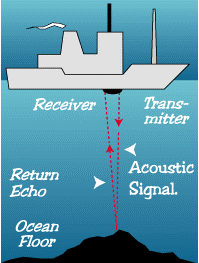
The sinking of them British liner Titanic in 1912, after it collided with an iceberg, spurred scientists to find a means of detecting underwater obstacles. And early form of sound detection was used by British and American forces for submarine detection during the First World War. Modern sonar (sound detection and ranging), which uses the echoes from emitted sounds, was developed by the French scientist Paul Langevin.
Today, echo sounding is used in ship navigation to determine water depth and by fishing vessels to spot shoals of fish, as well as for Marine research and mapping the seabed. Sound pulses, generated electronically, are beamed through the water and echoed back to the ship by any obstacle up to about 6 miles (10 km) away. The returning signals are displayed on a video screen.
Sound travels through water at about 1600yds (1500m) a second – around four times faster than in air. As with radar, the distance to the obstacle is calculated from the time the echo takes to return, and the Doppler shift of the sound waves shows if the object is moving.
Picture Credit : Google

